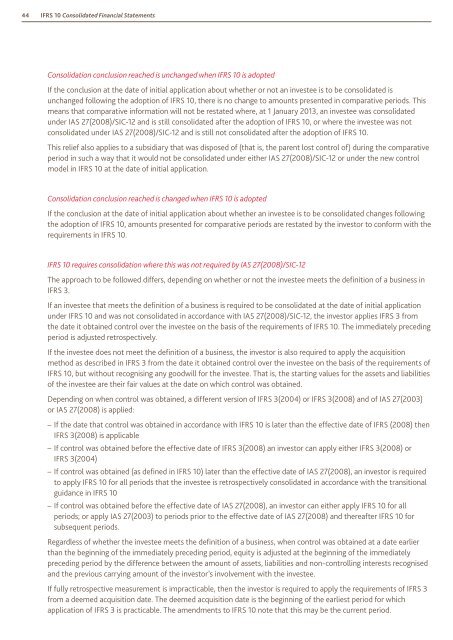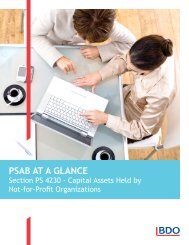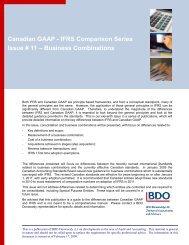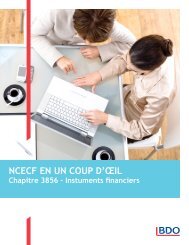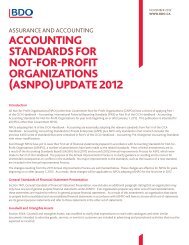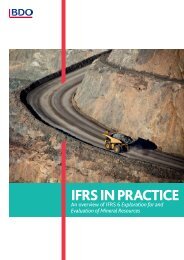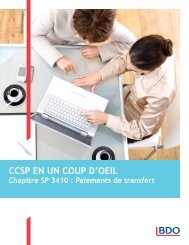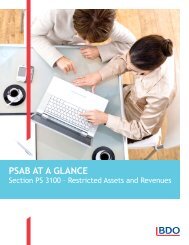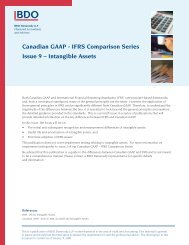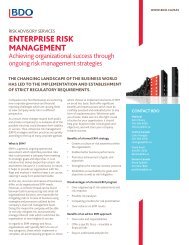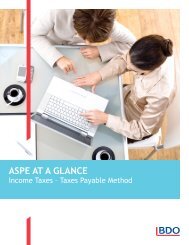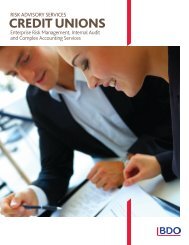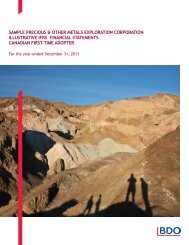Need to Know: IFRS 10 - Consolidated Financial ... - BDO Canada
Need to Know: IFRS 10 - Consolidated Financial ... - BDO Canada
Need to Know: IFRS 10 - Consolidated Financial ... - BDO Canada
- No tags were found...
Create successful ePaper yourself
Turn your PDF publications into a flip-book with our unique Google optimized e-Paper software.
44 <strong>IFRS</strong> <strong>10</strong> <strong>Consolidated</strong> <strong>Financial</strong> StatementsConsolidation conclusion reached is unchanged when <strong>IFRS</strong> <strong>10</strong> is adoptedIf the conclusion at the date of initial application about whether or not an investee is <strong>to</strong> be consolidated isunchanged following the adoption of <strong>IFRS</strong> <strong>10</strong>, there is no change <strong>to</strong> amounts presented in comparative periods. Thismeans that comparative information will not be restated where, at 1 January 2013, an investee was consolidatedunder IAS 27(2008)/SIC-12 and is still consolidated after the adoption of <strong>IFRS</strong> <strong>10</strong>, or where the investee was notconsolidated under IAS 27(2008)/SIC-12 and is still not consolidated after the adoption of <strong>IFRS</strong> <strong>10</strong>.This relief also applies <strong>to</strong> a subsidiary that was disposed of (that is, the parent lost control of) during the comparativeperiod in such a way that it would not be consolidated under either IAS 27(2008)/SIC-12 or under the new controlmodel in <strong>IFRS</strong> <strong>10</strong> at the date of initial application.Consolidation conclusion reached is changed when <strong>IFRS</strong> <strong>10</strong> is adoptedIf the conclusion at the date of initial application about whether an investee is <strong>to</strong> be consolidated changes followingthe adoption of <strong>IFRS</strong> <strong>10</strong>, amounts presented for comparative periods are restated by the inves<strong>to</strong>r <strong>to</strong> conform with therequirements in <strong>IFRS</strong> <strong>10</strong>.<strong>IFRS</strong> <strong>10</strong> requires consolidation where this was not required by IAS 27(2008)/SIC-12The approach <strong>to</strong> be followed differs, depending on whether or not the investee meets the definition of a business in<strong>IFRS</strong> 3.If an investee that meets the definition of a business is required <strong>to</strong> be consolidated at the date of initial applicationunder <strong>IFRS</strong> <strong>10</strong> and was not consolidated in accordance with IAS 27(2008)/SIC-12, the inves<strong>to</strong>r applies <strong>IFRS</strong> 3 fromthe date it obtained control over the investee on the basis of the requirements of <strong>IFRS</strong> <strong>10</strong>. The immediately precedingperiod is adjusted retrospectively.If the investee does not meet the definition of a business, the inves<strong>to</strong>r is also required <strong>to</strong> apply the acquisitionmethod as described in <strong>IFRS</strong> 3 from the date it obtained control over the investee on the basis of the requirements of<strong>IFRS</strong> <strong>10</strong>, but without recognising any goodwill for the investee. That is, the starting values for the assets and liabilitiesof the investee are their fair values at the date on which control was obtained.Depending on when control was obtained, a different version of <strong>IFRS</strong> 3(2004) or <strong>IFRS</strong> 3(2008) and of IAS 27(2003)or IAS 27(2008) is applied:––If the date that control was obtained in accordance with <strong>IFRS</strong> <strong>10</strong> is later than the effective date of <strong>IFRS</strong> (2008) then<strong>IFRS</strong> 3(2008) is applicable––If control was obtained before the effective date of <strong>IFRS</strong> 3(2008) an inves<strong>to</strong>r can apply either <strong>IFRS</strong> 3(2008) or<strong>IFRS</strong> 3(2004)––If control was obtained (as defined in <strong>IFRS</strong> <strong>10</strong>) later than the effective date of IAS 27(2008), an inves<strong>to</strong>r is required<strong>to</strong> apply <strong>IFRS</strong> <strong>10</strong> for all periods that the investee is retrospectively consolidated in accordance with the transitionalguidance in <strong>IFRS</strong> <strong>10</strong>––If control was obtained before the effective date of IAS 27(2008), an inves<strong>to</strong>r can either apply <strong>IFRS</strong> <strong>10</strong> for allperiods; or apply IAS 27(2003) <strong>to</strong> periods prior <strong>to</strong> the effective date of IAS 27(2008) and thereafter <strong>IFRS</strong> <strong>10</strong> forsubsequent periods.Regardless of whether the investee meets the definition of a business, when control was obtained at a date earlierthan the beginning of the immediately preceding period, equity is adjusted at the beginning of the immediatelypreceding period by the difference between the amount of assets, liabilities and non-controlling interests recognisedand the previous carrying amount of the inves<strong>to</strong>r’s involvement with the investee.If fully retrospective measurement is impracticable, then the inves<strong>to</strong>r is required <strong>to</strong> apply the requirements of <strong>IFRS</strong> 3from a deemed acquisition date. The deemed acquisition date is the beginning of the earliest period for whichapplication of <strong>IFRS</strong> 3 is practicable. The amendments <strong>to</strong> <strong>IFRS</strong> <strong>10</strong> note that this may be the current period.


